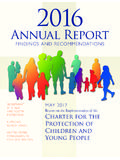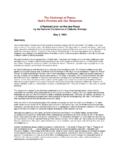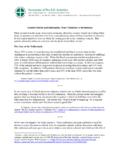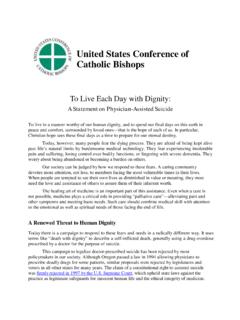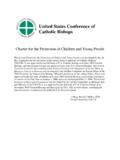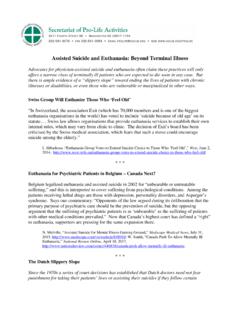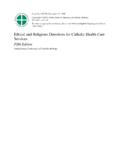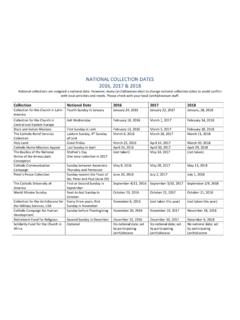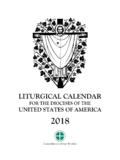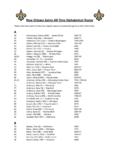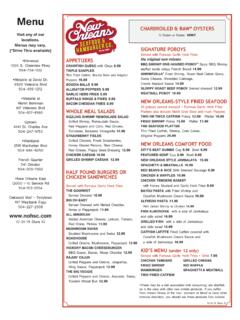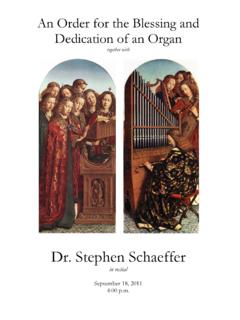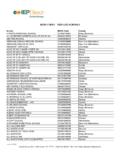Transcription of Preparing the Liturgy of the Hours, Second Edition
1 9 Preparing the Liturgy of the Hours, Second Edition Two significant events favor the present revision of the English translation of the Liturgy of the Hours. The first occurred in 1985, when the Holy See promulgated the Latin text of the Liturgia Horarum, editio typica altera. This Second Edition made a number of adjustments to the Latin text to bring it into closer conformity with the Neo-Vulgate translation of Scripture. One of the most noticeable revisions, however, is the addition of new antiphons for the Gospel Canticles at Morning and Evening Prayer on Sundays and solemnities. Instead of offering a single antiphon for each canticle as in the present English translation (the Magnificat antiphon for Evening Prayer I is usually from Year A, the Benedictus antiphon at Morning Prayer is from Year B, and the Magnificat antiphon for Evening Prayer II is from Year C), the revised Latin text provides three antiphons for each Gospel Canticle, a designated proper antiphon for Lectionary years A, B, and C.
2 Each of the antiphons echoes a theme or passage from the particular Gospel reading for that year. The users of some vernacular translations, including Spanish and Portuguese, are already familiar with and accustomed to these additional antiphons on Sundays and solemnities. However, the present English translation of the Liturgy of the Hours dates from the early 1970s. Since the 1985 revision to the Latin text has up to now never been translated into English, the choice of three antiphons may appear novel to those praying in English. The Second event encouraging a revision of the Divine Office was the implementation of the Roman Missal, Third Edition in 2011.
3 With new translations of the Collect prayers, the close link between the celebration of the Mass and the Liturgy of the Hours on Sundays, feast days, and during certain liturgical times of the year was weakened. Whereas prior to 2011 the concluding prayer for the various hours was generally identical to the Collect for the Mass that day, now the celebration of the Mass and the praying of the Liturgy of the Hours employ two often very diverse translations of the same Latin prayers. In addition, the other Latin texts for the Liturgy of the Hours need to be revised in accordance with Liturgiam authenticam, the 2001 instruction from the Holy See which guided the revision of the Roman Missal.
4 The revision of the Liturgy of the Hours was initially envisioned as a relatively simple project, where only a few texts would have to be retranslated. The appropriate Collects could be imported from the Roman Missal, and the Psalmody and other scriptural components simply supplied from their latest approved translations. However, as work began on the project, it quickly became clear that the various liturgical elements were so intertwined, that to alter the translation of one entailed reviewing others as well for consistency of style and vocabulary. Therefore a more Volume LI March 2015 Members Most Rev.
5 Arthur J. Serratelli, Chair Bishop of Paterson Justin F. Cardinal Rigali Archbishop Emer. of Philadelphia Most Rev. Gregory M. Aymond Archbishop of New Orleans Most Rev. Leonard P. Blair Archbishop of Hartford Most Rev. Edward K. Braxton Bishop of Belleville Most Rev. Mark J. Seitz Bishop of El Paso Most Rev. Daniel E. Thomas Bishop of Toledo Most Rev. Octavio Cisneros Auxiliary Bishop of Brooklyn Most Rev. Paul R. Sanchez Auxiliary Bishop of Brooklyn Consultants Francis E. Cardinal George, Archbishop Emeritus of Chicago Right Rev. Gregory J. Polan, OSB Abbot of Conception Abbey Rev. Msgr. Kevin W.
6 Irwin Rev. Jan Michael Joncas Rev. Thomas C. Ranzino Rev. Juan J. Sosa Sr. Janet Baxendale, SC Mrs. Rita A. Thiron Secretariat Rev. Michael J. Flynn Executive Director Ms. Sylvia L. S nchez Multicultural Specialist Mr. Matthew M. Godbey Administrative Assistant Ms. Hannah R. Dell Staff Assistant USCCB Secretariat of Divine Worship 3211 Fourth Street, NE Washington, DC 20017 Tel: (202) 541 3060 Fax: (202) 541 3088 2015 USCCB 10 thorough revision of the texts was called for, and that revision would involve a much more complex and time-consuming process. Elements of the Divine Office are either Scriptural in nature, or non-Scriptural; the USCCB is responsible for Scriptural elements, and the International Commission on English in the Liturgy (ICEL) provides translations of the non-Scriptural portions for the approval of the English-speaking Conferences of Bishops.
7 Revised Grail Psalms The source of the Psalmody in the present English translation of the Liturgy of the Hours is the Grail Psalms, a Psalter long noted for its poetic qualities and for its consistently metrical translations, which greatly facilitate both singing and common recitation. In November 2008, the Bishops of the USCCB approved a revised version of these Psalms, called the Revised Grail Psalms (RGP), as the official Psalter for use in future liturgical texts, including the Liturgy of the Hours. The RGP, with some corrections, was confirmed by the Holy See in 2010. Additional corrections and adjustments were proposed and approved by the USCCB in November 2014, and are being prepared for submission to the Congregation for Divine Worship and the Discipline of the Sacraments for the requisite confirmation.
8 Old Testament, New Testament, and Gospel Canticles In addition to the Psalms, three Hours Morning, Evening, and Night Prayer include canticles derived from other Scriptural sources. These three Hours also include the important and well-known Gospel Canticles of Zechariah (Benedictus), Mary (Magnificat), and Simeon (Nunc Dimittis) from the Gospel of St. Luke. The monks of Conception Abbey prepared translations of these canticles in a poetic and rhythmic style similar to the RGP. Having undergone a preliminary review, the body of Bishops will vote on the amended versions at the June 2015 USCCB plenary meeting.
9 If approved by the Bishops, the texts will be submitted to the Congregation for recognitio. The Old Testament and other New Testament canticles in the present English translation are taken from the 1970 Edition of the New American Bible. Although every effort was made at the time to present them in sense lines and in a manner conducive to singing or community recitation, some of the canticles in the breviary present difficulties for communities. One notable example comes from Ephesians 1:3-10, which occurs in the Psalter every Monday at Evening Prayer: God chose us in him / before the world began / to be holy / and blameless in his sight.
10 With its uneven lines and random accented syllables, few communities make it through this strophe without stumbling. The proposed Conception Abbey canticles remedy the awkwardness found in some of the Old and New Testament Canticles without compromising accuracy of translation. Scriptural Readings Every liturgical hour includes other passages of Scripture, either in the form of brief passages (lectiones breves) in most of the Hours, or in more extensive passages found in the Office of Readings. The revised Liturgy of the Hours will draw from the New American Bible, Revised Edition (NABRE). A revision of the Old Testament was completed in 2010 but still requires approval by the Holy See for liturgical use; the revision of the New Testament is well underway.
